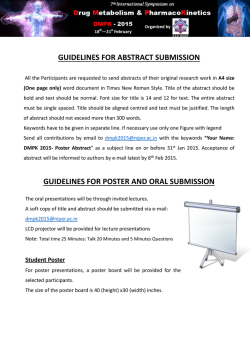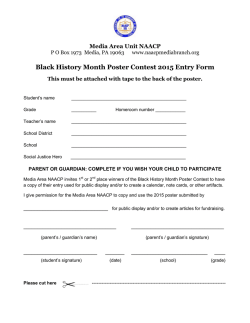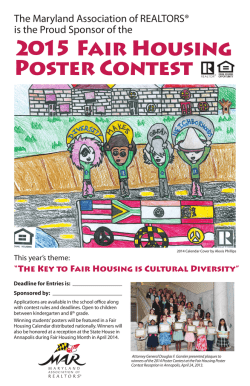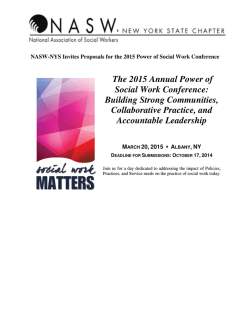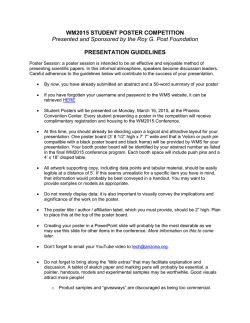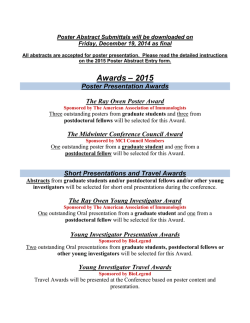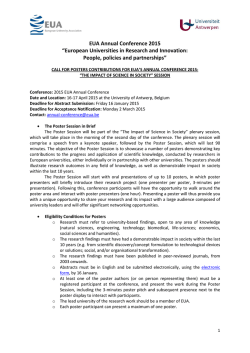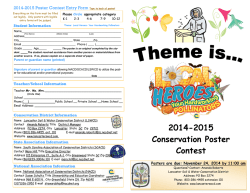
poster presentations - American Academy of Orthopaedic Surgeons
American Academy of Orthopaedic Surgeons 2015 Annual Meeting • March 24-28 • Las Vegas, Nevada POSTER PRESENTATIONS Mark your calendar! A poster awards ceremony is taking place on Friday, March 27th at 7:00 AM. A free continental breakfast will be available. The winning poster presenters in each classification will make a brief presentation and an overall winner will be selected. Key Information Disclosure: You are required to indicate the complete financial disclosure of all of the authors under the title of your poster. Below is a sample of a proper disclosure format: This is the Title of My 2015 AAOS Annual Meeting Poster Presentation Presenter Name (n), Co-Author 1 Name (3A, 3B – Stryker), Co-Author 2 Name (1 – Zimmer), Co-Author 3 Name (n), Co-Author 4 Name (n), Co-Author 5 Name (n), Co-Author 6 Name (n) Disclosure Key: n = Nothing to disclose, 1 = Royalties from a company or supplier 2 = Speakers bureau/paid presentations for a company or supplier 3A = Paid employee for a company or supplier 3B = Paid consultant for a company or supplier 3C = Unpaid consultant for a company or supplier 4 = Stock or stock options in a company or supplier 5 = Research support from a company or supplier as a PI 6 = Other financial or material support from a company or supplier 7 = Royalties financial or material support from publishers To search and view your co-authors disclosure go to: www.aaos.org/disclosure As an accepted Poster at the Annual Meeting you are required to submit your poster in 2 formats, as a traditional (hardcopy) 4’ x 6’.6” poster, and electronic poster (ePoster). Posters are viewed during the entire meeting in Academy Hall, Venetian/Sands EXPO. Set up of posters: Monday, March 23: 2:00 – 6:00 PM Tuesday, March 24: 8:00 – 10:00 AM (Academy Hall will be open during set up) Viewing Hours are: Tuesday – 8:00 AM – 6:00 PM Wednesday-Friday, 7:00 AM – 6:00 PM Saturday 7:00 AM – 3:00 PM Dismantling of posters: Saturday, March 28, 3:00 – 4:00 PM (You may remove your poster after 3:00 PM without penalty). One of the authors of the poster needs to be present Wednesday-Friday from 11:30 AM - 12:30 PM for questions. If your poster is selected as an award winner or for a poster tour, one or more of the authors should be present at the event. Food and Drug Administration Status: If a device or drug requiring FDA approval is covered by the material used in the poster, the poster must include the FDA clearance status of the medical devices and pharmaceuticals for the uses discussed or described. "Off label" uses of a device or pharmaceutical may be described so long as the lack of FDA clearance for such uses is also disclosed. Ensure that your poster complies with HIPAA (Health Insurance Portability and Accountability Act), this protects a patient’s rights and confidentiality. Commercialism: Funding of poster exhibits is limited to individuals, educational facilities and hospitals. Commercial funding is not allowed. Contact information for the presenter including last name, shipping address and poster number, should be placed on the back side of the poster on the upper left corner. Equipment Supplied By the Academy Tack board (4’ high x 6’6” Wide) (121.9cm x 198.2cm) Letter size bin attaches to the tack board for handouts Set-Up of Poster It is important that the poster be planned and constructed carefully so it can be placed on its 4’ high x 6’6” (121.9cm x 198.2cm) wide tack board in final form in 30 minutes or less. Your poster can be any size as long as it does not go over the poster board boundaries. (There is no standard size or format for a traditional poster. The only format that should be followed is the disclosure format which you can see a sample of above) Attach the poster with thumbtacks or push pins. Tapes, glues, or other messy or permanent substances are not appropriate for use on tack boards. The Academy has a Help Desk, which has supplies for securing your poster presentation. Why a Poster? A poster presentation is an excellent way to provide continuing education and highlight your important research. The compact format provides a step-by-step explanation of procedures and results of scientific research or multiple case studies. The public display of the presentation allows viewers to examine the information at their own pace. An added benefit is the one-on-one contact between presenter and viewer that can take place during the formal poster presentation time. Effective posters communicate by the written word, visual illustrations, and the presenter’s personality. Poster presentations are best suited for a pilot study, a unique idea, or a new procedure where all information can be displayed on a 4’ high x 6’ 6” wide tack board(121.9cm x 198.2cm). Only text, graphs, photographs, and artwork are placed on the board. Ideally, the poster presentation should have a handout that reflects the research. Elements of a Poster The following suggestions may be helpful in planning and preparing a poster presentation: The topic should be relevant. Data displayed clear and concise, allowing readers to make own interpretation. Photos, figures, diagrams, charts to reflect pertinent points. Findings and conclusions clearly discernible from the text. Useful information for clinical practice. Good science – case controlled study. Focused – makes a statement, offers proof, and draws conclusions. Legible – large enough print to be read 4’ to 6’ away. Quality – professional, appropriate for national scientific presentation. Definition of clinically meaningful problem. Hypothesis and purpose. Succinct take-home message in conclusion. Limited verbiage. Use photos to substitute for words. State the problem, the approach to the solution, then, give the work performed and result. Conclude only what data supports. Speculation is OK, but let the reader know what you speculate and what your data supports. Avoid abbreviations and acronyms without giving their full form. Artwork and Lettering Creative artwork with an uncluttered layout will encourage attendees to stop and examine your poster presentation. Use self-explanatory drawings, photos and charts to express ideas. When captions are used, limit them to a couple of sentences. Avoid USING ENTIRELY CAPITAL LETTERS IN ALL INSTANCES, otherwise the text will be too difficult to read. Color is very useful for creating interest and accentuating specific parts of any presentation. Use only a few common colors. Generally, it is best to use light lettering (e.g., white, yellow, golden yellow, ivory, light blue, cyan) on dark backgrounds (e.g., royal blue, navy blue, teal green, forest green or purple). Colors like red, magenta, and orange can work well, as accents, but they are too “hot” for use over large areas of a display. Fluorescent colors, while eye-catching, do not carry the professional image you want to project. Most importantly, make sure the color combinations you select are visually appealing. Self Critique One of the best ways to assess the effectiveness of your presentation is to assemble it at your office and critique it yourself as if you were a meeting attendee seeing the material for the first time. Introduce objectivity into this process by making a checklist of the essential characteristics of a good poster presentation. Then, rate your poster. If it doesn’t make the elements of a good poster continue to improve your presentation. ePoster As a poster presenter, you are required to submit your poster in 2 formats, as a traditional poster and an electronic (ePoster) version. You can find ePoster templates and submit your poster at www.scientificposters.aaos.org Poster Help Desk A Poster and Scientific Exhibit Help Desk will be located in the Poster and Scientific Exhibit area to assist you on-site. The Poster Help Desk will store your tubes or shipping material, provide pushpins, Velcro and handout bins. They can also provide you with general information about the meeting. Poster Awards An award will be presented in each classification designating the best poster of that classification. The top five rated abstracts in each classification are eligible for the award. If yours is one of the top five, you will be notified. From these winners, the Central Program Committee Chair will select the best poster of the 2014 AAOS Annual Meeting. In order to be eligible, your poster must be displayed by the opening of the poster exhibits on Tuesday, March 28th at 8:00 AM. If you have any questions about a poster presentation, you may e-mail: Scottie Rangel Education Assistant [email protected] 847/384-4185 April Holmes Education Coordinator [email protected] 847/384-4189 Kathie Niesen Education Manager [email protected] 847/384-4184
© Copyright 2025
